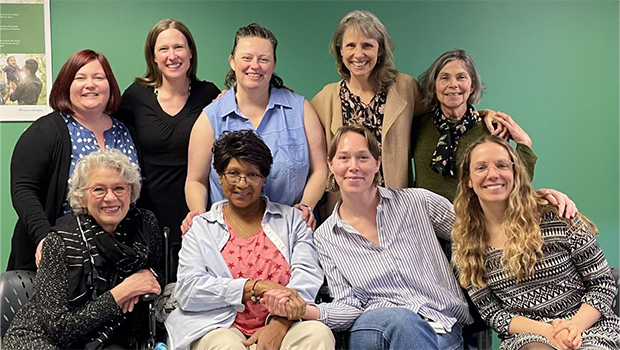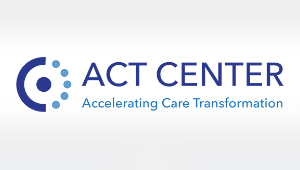Virtual patient engagement: ‘A safe place’ to be ourselves

ACT Center patient partners and researchers on the Integrated Pain Management team gather to celebrate their collaboration. Bottom row, from left: Kathryn Ramos, Starette Canada, Sunday Brush, and Jess Mogk. Top row, from left: Kelsey Stefanik-Guizlo, Claire Allen, Marina Peck, Paula Lozano, and Karen Volpe.
A Kaiser Permanente Washington member shares her experience as a patient partner with the Integrated Pain Management Program
When the COVID-19 lockdown became a reality in spring of 2020, research teams across the country were forced to revamp their approaches to engaging patients and community members in research. For the Integrated Pain Management (IPM) Program led by Kaiser Permanente Washington’s Center for Accelerating Care Transformation (ACT Center), virtual patient engagement — that is, meeting regularly with patient partners online — quickly emerged as a promising option.
Launched in late 2019, the IPM Program was built to incorporate the voices of patients in the design of a safe, whole-person approach to providing care for people with persistent pain. Now, after several years of successful collaboration, the IPM Program’s team of patient partners and researchers are sharing what they learned about working together virtually in a new paper: Sustaining connections: feasibility and impact of long-term virtual patient engagement. Published recently in Research Involvement and Engagement, the paper provides insight into how researchers can structure virtual patient partner activities to encourage and maintain deep engagement over time.
Kathryn Ramos, a longtime Kaiser Permanente member who lives with ongoing pain, was among the team of patient partners and ACT Center researchers who authored the paper. In this Q&A, she talks about why she chose to participate in the IPM Program, what it was like to collaborate virtually, and what she hopes other researchers will prioritize as they engage patients and communities in the future.
What motivated you to volunteer to be a patient partner on IPM?
When the ACT Center first invited me to participate in the IPM Program, it was spring of 2020 and we were 2 months into the COVID-19 lockdown. Because of COVID, the team of IPM researchers and patient partners would be meeting virtually, at least for the time being. I was feeling isolated and ready to collaborate with others, even if it was virtual! Plus, I was intrigued by the opportunity to share my experience as someone who lives with ongoing pain.
As a retired staff member from the patient health education team at Kaiser Permanente Washington, I’d facilitated groups and worked with patients to design tools to help them manage their health. I’d encouraged patients to tell their stories, to share their experiences and strategies, rarely inserting my opinion or telling my own story. Being a patient partner on IPM would be an opportunity to be on the other side — to offer my perspective as a patient and person living with and managing my own health condition.
What was it like to collaborate in a virtual environment?
Our team included 4 patient partners and 5 researchers. It wasn’t long before the lines between “researcher” and “patient partner” blurred, as we came to our virtual meeting space monthly to connect personally and professionally. The researchers were role models in providing a virtual framework that was safe and respectful. We all, including the researchers, shared personal stories and opinions without censorship or judgement. We developed trust in each other and in the process.
We continued to meet virtually over the next 3 ½ years — only meeting in person 3 times to celebrate our accomplishments and share food! Surprisingly, as patient partners, the consensus was that meeting virtually leveled the playing field. Because we could “Zoom” in from anywhere, we weren’t limited by geography or mobility, which enhanced our communication and ability to be fully present and be ourselves.
The virtual environment was a safe place to see and be seen. We didn’t have to dress up or strive to make an impression. We could express ourselves in the comfort and security of our own physical space, allowing those of us with social anxieties or tendencies to be introverted or introspective to feel accepted and heard.
What advice would you offer to other research teams who are prioritizing patient engagement?
Going forward, I encourage researchers to do their best to give patient partners a sense of equal footing and allow them space to comfortably be themselves. Whether virtual or in-person, having a partnership that feels equal and authentic makes it easier for patients and researchers to work together to achieve their goals. And when the goal is to develop resources that engage and activate patients in managing their health, it’s essential that researchers elevate the voices of real patients in their messaging.
Through IPM, the other patient partners and I collaborated on several pain management resources for both providers and patients, the highlight of which was our Toolkit for Managing Persistent Pain (also available in Spanish). We made the important decision to write the toolkit from our perspectives as patients, which helped us focus the content on what is most important to people like us. Plus, we helped ensure that the information was delivered in respectful, understandable language that wasn’t stigmatizing or demeaning. The level of cooperation and input from all the patient partners was truly inspiring, and the final product is a testament to the knowledge and talents of each of us.
Kathryn Ramos’s coauthors on Sustaining connections: feasibility and impact of long-term virtual patient engagement include patient partners Starette Canada, Marina Peck, and Karen Volpe; and ACT Center researchers Kelsey Stefanik-Guizlo (lead author), Claire Allen, Sunday Brush, Jessica Mogk, and Paula Lozano.
This was adapted from a story originally published by the ACT Center.
Healthy findings blog

Patient partners: A missing ingredient at conferences?
Starette Canada, a patient partner, shares her experience at a recent conference and highlights gaps in patient engagement.
News

Toolkit offers guidance for people with persistent pain
The new comprehensive resource was written from the perspective of patients experiencing ongoing pain.
Visit the ACT Center

Moving research into action, together
KPWHRI’s Center for Accelerating Care Transformation improves health for people and communities by streamlining the path from research to practice.


